Page 2180 of 2890
K: TROUBLE CODE 31
—THROTTLE POSITION SENSOR—
DIAGNOSIS:
Input signal circuit of throttle position sensor is open or
shorted.
TROUBLE SYMPTOM:
Shift point too high or too low; engine brake not effected in
“3”range; excessive shift shock; excessive tight corner
“braking”
1. Check harness connector between TCM and
throttle position sensor.
OK
�Not OK
Repair or replace harness connectors.
2. Check throttle position sensor.
OK
�Not OK
Replace throttle position sensor.
3. Check input signal for TCM.
Not OK
�OK
�Repair TCM connector terminal poor contact.
�Replace TCM.
4. Check power supply to throttle position
sensor.
OK
�Not OK
Repair or replace harness connectors.
�Repair TCM connector terminal poor contact.
�Replace TCM.
B2M0613
�
�
�
�
40
3-2AUTOMATIC TRANSMISSION AND DIFFERENTIAL
7. Diagnostic Chart with Trouble Code
Page 2181 of 2890
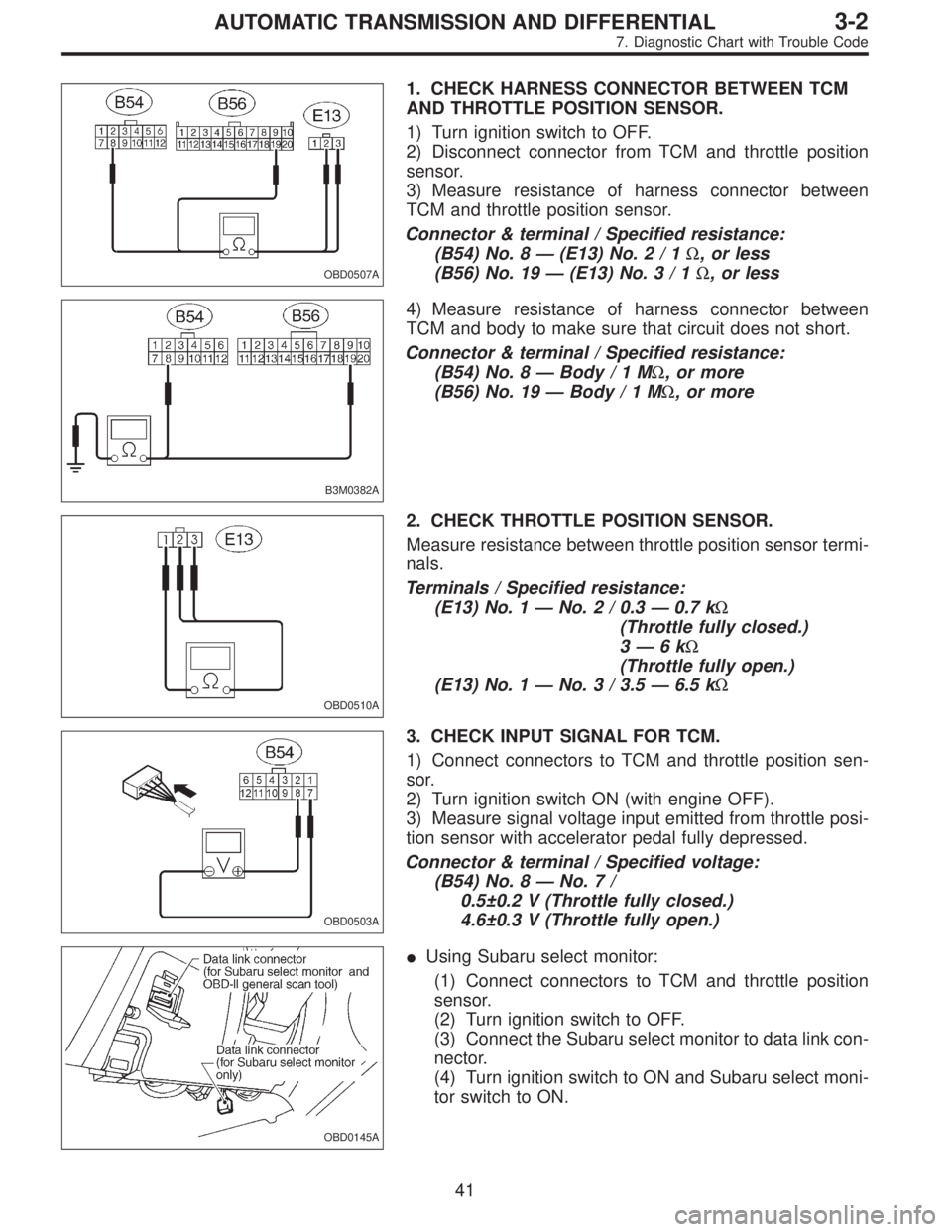
OBD0507A
1. CHECK HARNESS CONNECTOR BETWEEN TCM
AND THROTTLE POSITION SENSOR.
1) Turn ignition switch to OFF.
2) Disconnect connector from TCM and throttle position
sensor.
3) Measure resistance of harness connector between
TCM and throttle position sensor.
Connector & terminal / Specified resistance:
(B54) No. 8—(E13) No.2/1Ω, or less
(B56) No. 19—(E13) No.3/1Ω, or less
B3M0382A
4) Measure resistance of harness connector between
TCM and body to make sure that circuit does not short.
Connector & terminal / Specified resistance:
(B54) No. 8—Body/1MΩ, or more
(B56) No. 19—Body/1MΩ, or more
OBD0510A
2. CHECK THROTTLE POSITION SENSOR.
Measure resistance between throttle position sensor termi-
nals.
Terminals / Specified resistance:
(E13) No. 1—No. 2 / 0.3—0.7 kΩ
(Throttle fully closed.)
3—6kΩ
(Throttle fully open.)
(E13) No. 1—No. 3 / 3.5—6.5 kΩ
OBD0503A
3. CHECK INPUT SIGNAL FOR TCM.
1) Connect connectors to TCM and throttle position sen-
sor.
2) Turn ignition switch ON (with engine OFF).
3) Measure signal voltage input emitted from throttle posi-
tion sensor with accelerator pedal fully depressed.
Connector & terminal / Specified voltage:
(B54) No. 8—No.7/
0.5±0.2 V (Throttle fully closed.)
4.6±0.3 V (Throttle fully open.)
OBD0145A
�Using Subaru select monitor:
(1) Connect connectors to TCM and throttle position
sensor.
(2) Turn ignition switch to OFF.
(3) Connect the Subaru select monitor to data link con-
nector.
(4) Turn ignition switch to ON and Subaru select moni-
tor switch to ON.
41
3-2AUTOMATIC TRANSMISSION AND DIFFERENTIAL
7. Diagnostic Chart with Trouble Code
Page 2185 of 2890
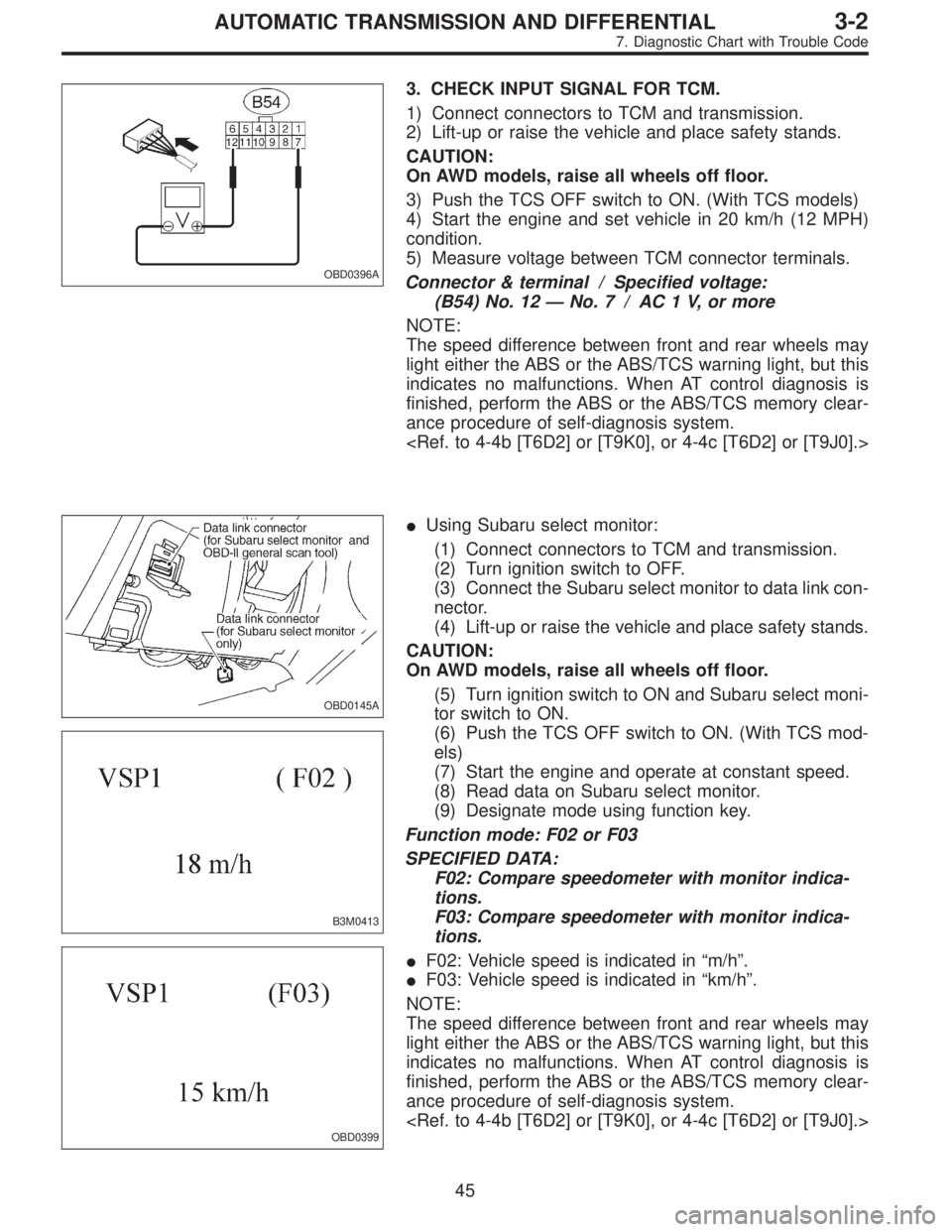
OBD0396A
3. CHECK INPUT SIGNAL FOR TCM.
1) Connect connectors to TCM and transmission.
2) Lift-up or raise the vehicle and place safety stands.
CAUTION:
On AWD models, raise all wheels off floor.
3) Push the TCS OFF switch to ON. (With TCS models)
4) Start the engine and set vehicle in 20 km/h (12 MPH)
condition.
5) Measure voltage between TCM connector terminals.
Connector & terminal / Specified voltage:
(B54) No. 12—No. 7 / AC 1 V, or more
NOTE:
The speed difference between front and rear wheels may
light either the ABS or the ABS/TCS warning light, but this
indicates no malfunctions. When AT control diagnosis is
finished, perform the ABS or the ABS/TCS memory clear-
ance procedure of self-diagnosis system.
OBD0145A
B3M0413
OBD0399
�Using Subaru select monitor:
(1) Connect connectors to TCM and transmission.
(2) Turn ignition switch to OFF.
(3) Connect the Subaru select monitor to data link con-
nector.
(4) Lift-up or raise the vehicle and place safety stands.
CAUTION:
On AWD models, raise all wheels off floor.
(5) Turn ignition switch to ON and Subaru select moni-
tor switch to ON.
(6) Push the TCS OFF switch to ON. (With TCS mod-
els)
(7) Start the engine and operate at constant speed.
(8) Read data on Subaru select monitor.
(9) Designate mode using function key.
Function mode: F02 or F03
SPECIFIED DATA:
F02: Compare speedometer with monitor indica-
tions.
F03: Compare speedometer with monitor indica-
tions.
�F02: Vehicle speed is indicated in“m/h”.
�F03: Vehicle speed is indicated in“km/h”.
NOTE:
The speed difference between front and rear wheels may
light either the ABS or the ABS/TCS warning light, but this
indicates no malfunctions. When AT control diagnosis is
finished, perform the ABS or the ABS/TCS memory clear-
ance procedure of self-diagnosis system.
45
3-2AUTOMATIC TRANSMISSION AND DIFFERENTIAL
7. Diagnostic Chart with Trouble Code
Page 2187 of 2890
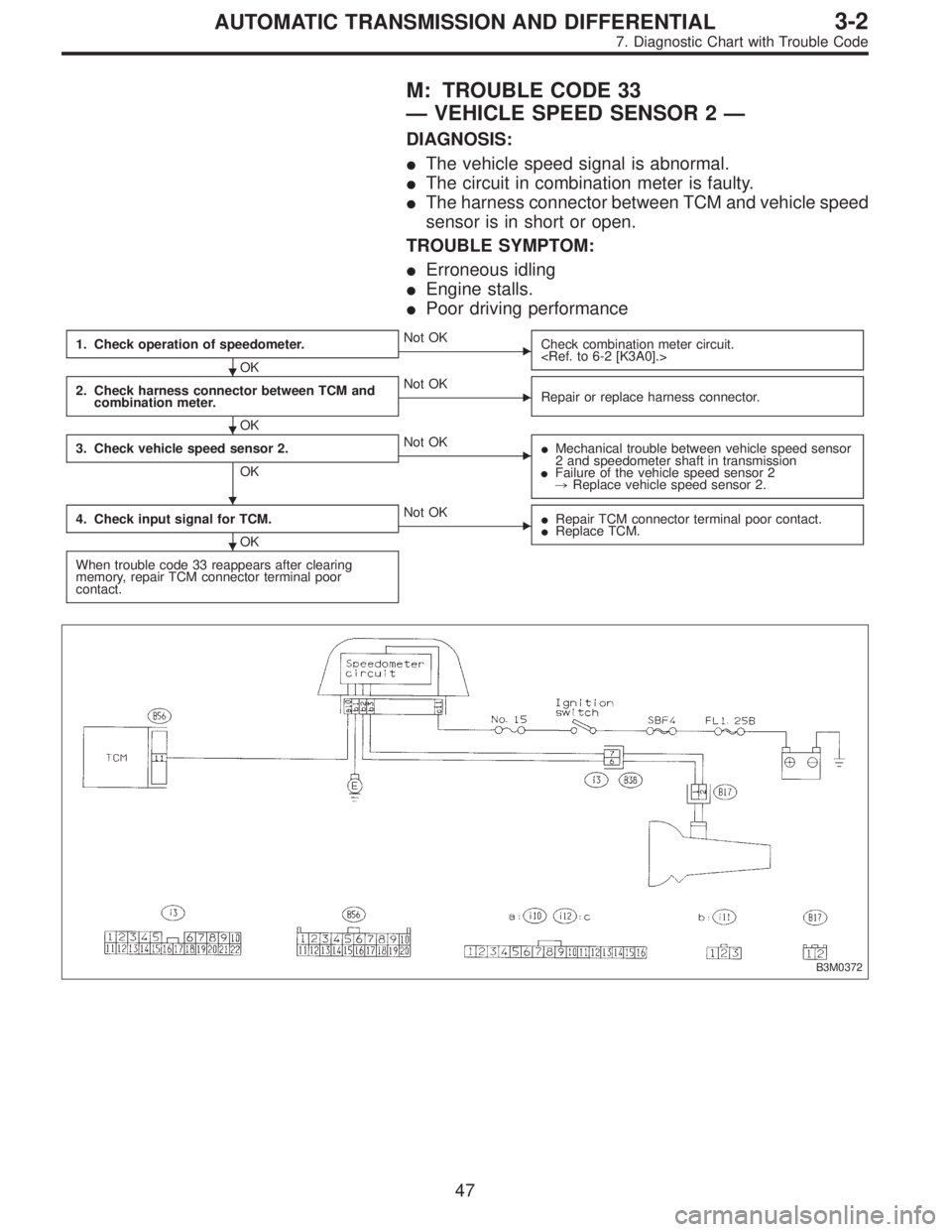
M: TROUBLE CODE 33
—VEHICLE SPEED SENSOR 2—
DIAGNOSIS:
�The vehicle speed signal is abnormal.
�The circuit in combination meter is faulty.
�The harness connector between TCM and vehicle speed
sensor is in short or open.
TROUBLE SYMPTOM:
�Erroneous idling
�Engine stalls.
�Poor driving performance
1. Check operation of speedometer.
OK
�Not OK
Check combination meter circuit.
2. Check harness connector between TCM and
combination meter.
OK
�Not OK
Repair or replace harness connector.
3. Check vehicle speed sensor 2.
OK
�Not OK
�Mechanical trouble between vehicle speed sensor
2 and speedometer shaft in transmission
�Failure of the vehicle speed sensor 2
,Replace vehicle speed sensor 2.
4. Check input signal for TCM.
OK
�Not OK
�Repair TCM connector terminal poor contact.
�Replace TCM.
When trouble code 33 reappears after clearing
memory, repair TCM connector terminal poor
contact.
B3M0372
�
�
�
�
47
3-2AUTOMATIC TRANSMISSION AND DIFFERENTIAL
7. Diagnostic Chart with Trouble Code
Page 2189 of 2890
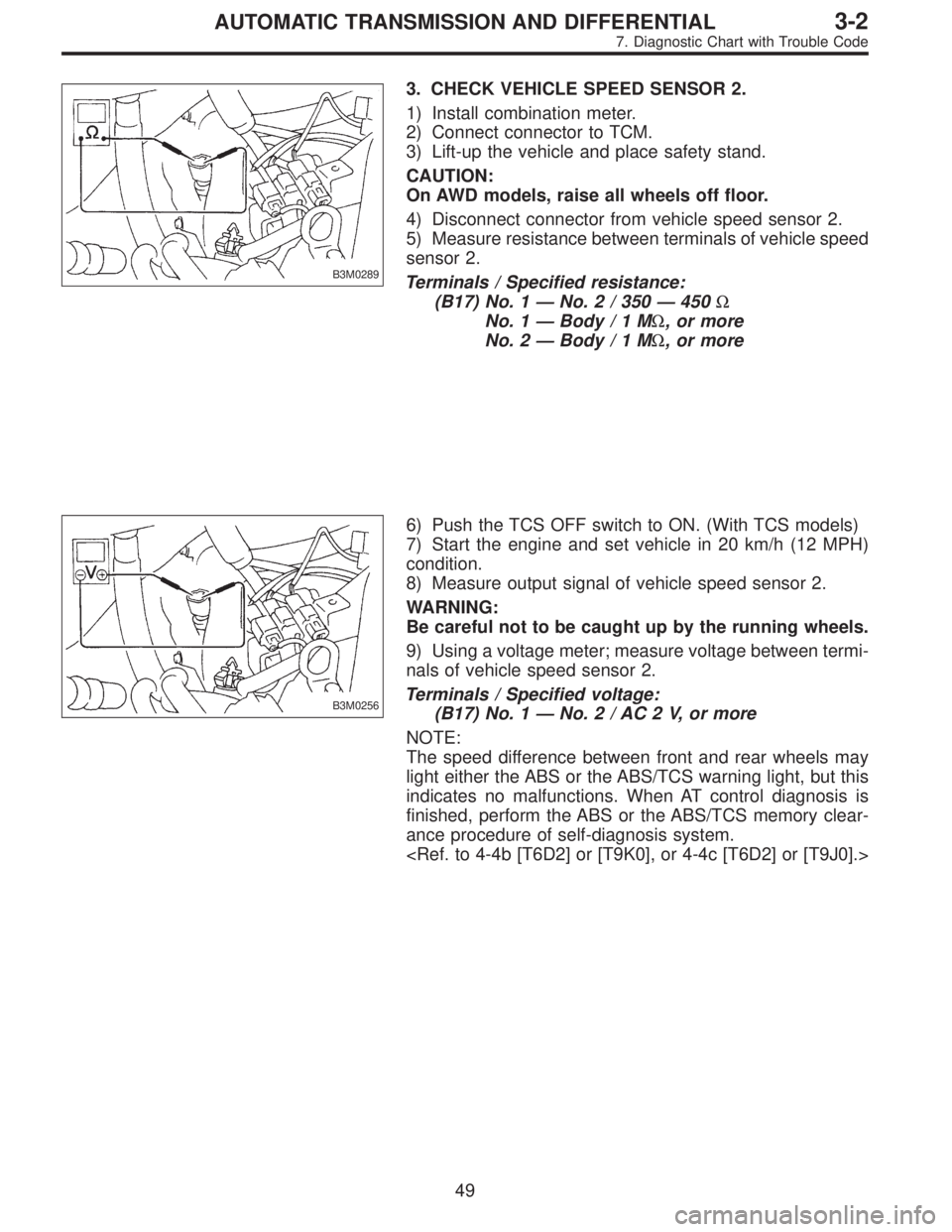
B3M0289
3. CHECK VEHICLE SPEED SENSOR 2.
1) Install combination meter.
2) Connect connector to TCM.
3) Lift-up the vehicle and place safety stand.
CAUTION:
On AWD models, raise all wheels off floor.
4) Disconnect connector from vehicle speed sensor 2.
5) Measure resistance between terminals of vehicle speed
sensor 2.
Terminals / Specified resistance:
(B17) No. 1—No. 2 / 350—450Ω
No. 1—Body/1MΩ, or more
No. 2—Body/1MΩ, or more
B3M0256
6) Push the TCS OFF switch to ON. (With TCS models)
7) Start the engine and set vehicle in 20 km/h (12 MPH)
condition.
8) Measure output signal of vehicle speed sensor 2.
WARNING:
Be careful not to be caught up by the running wheels.
9) Using a voltage meter; measure voltage between termi-
nals of vehicle speed sensor 2.
Terminals / Specified voltage:
(B17) No. 1—No. 2 / AC 2 V, or more
NOTE:
The speed difference between front and rear wheels may
light either the ABS or the ABS/TCS warning light, but this
indicates no malfunctions. When AT control diagnosis is
finished, perform the ABS or the ABS/TCS memory clear-
ance procedure of self-diagnosis system.
49
3-2AUTOMATIC TRANSMISSION AND DIFFERENTIAL
7. Diagnostic Chart with Trouble Code
Page 2190 of 2890
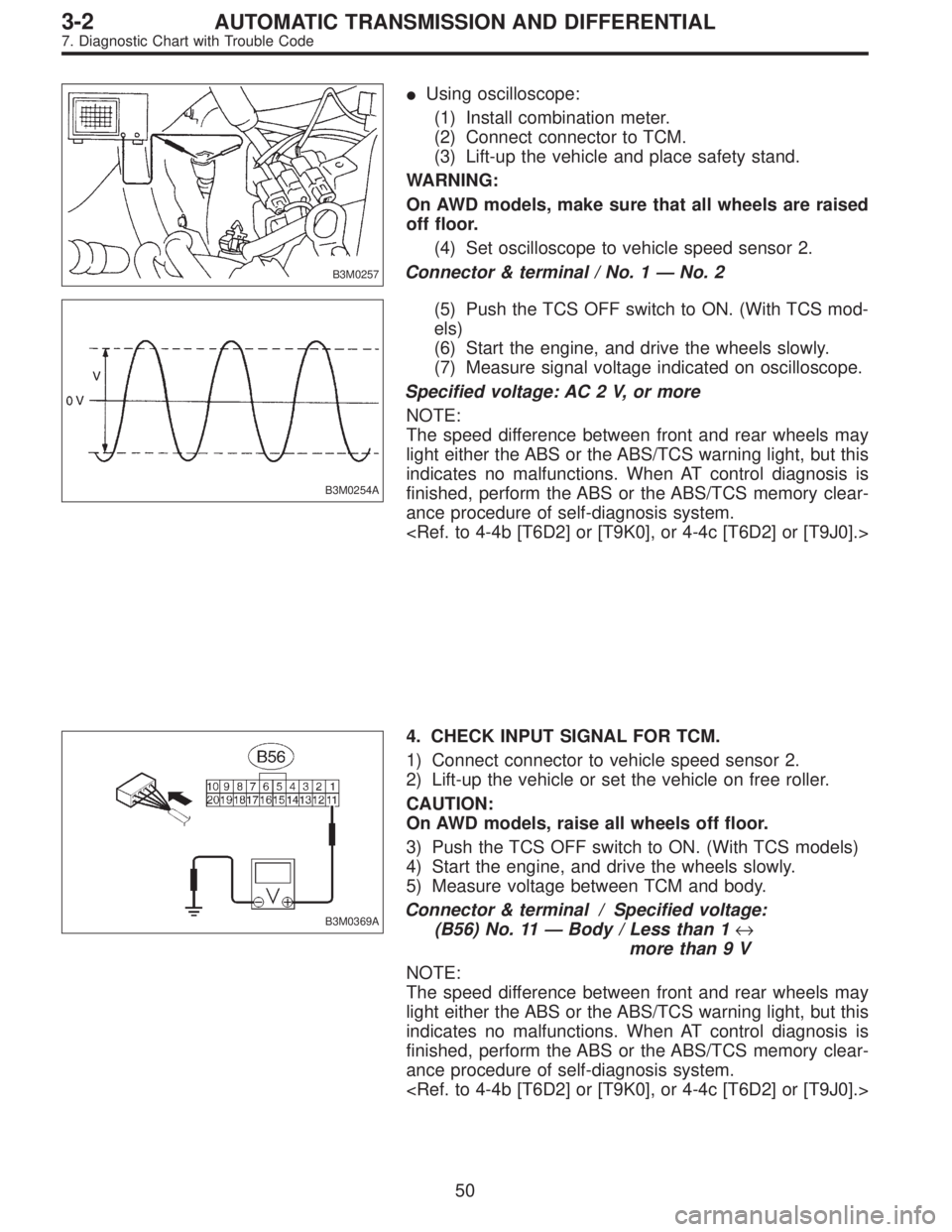
B3M0257
�Using oscilloscope:
(1) Install combination meter.
(2) Connect connector to TCM.
(3) Lift-up the vehicle and place safety stand.
WARNING:
On AWD models, make sure that all wheels are raised
off floor.
(4) Set oscilloscope to vehicle speed sensor 2.
Connector & terminal / No. 1—No. 2
B3M0254A
(5) Push the TCS OFF switch to ON. (With TCS mod-
els)
(6) Start the engine, and drive the wheels slowly.
(7) Measure signal voltage indicated on oscilloscope.
Specified voltage: AC 2 V, or more
NOTE:
The speed difference between front and rear wheels may
light either the ABS or the ABS/TCS warning light, but this
indicates no malfunctions. When AT control diagnosis is
finished, perform the ABS or the ABS/TCS memory clear-
ance procedure of self-diagnosis system.
B3M0369A
4. CHECK INPUT SIGNAL FOR TCM.
1) Connect connector to vehicle speed sensor 2.
2) Lift-up the vehicle or set the vehicle on free roller.
CAUTION:
On AWD models, raise all wheels off floor.
3) Push the TCS OFF switch to ON. (With TCS models)
4) Start the engine, and drive the wheels slowly.
5) Measure voltage between TCM and body.
Connector & terminal / Specified voltage:
(B56) No. 11—Body / Less than 1↔
more than 9 V
NOTE:
The speed difference between front and rear wheels may
light either the ABS or the ABS/TCS warning light, but this
indicates no malfunctions. When AT control diagnosis is
finished, perform the ABS or the ABS/TCS memory clear-
ance procedure of self-diagnosis system.
50
3-2AUTOMATIC TRANSMISSION AND DIFFERENTIAL
7. Diagnostic Chart with Trouble Code
Page 2196 of 2890
G3M0723
C: MODE F00—MODE DISPLAY—
SPECIFIED DATA:
Data at the left should be indicated.
Probable cause (if outside“specified data”)
1. Communication failure
(No communication method can be confirmed
with power ON.)
�(1)Check loose or poor connectors, or
shortcircuit.
(2) Check type of cartridge.
2. Vehicle types cannot be identified (due to
communication failure).�Check improper cartridge.
Replace with proper one.
G3M0724
D: MODE F01—BATTERY VOLTAGE (VB)—
CONDITION:
�Ignition switch ON
�Engine idling after warm-up
SPECIFIED DATA:
VB: 10—16 V
1. Battery�Check battery voltage and specific gravity of
electrolyte.
2. Charging system�(1)Measure regulating voltage under no loads.
(2) Check generator (as a single unit).
56
3-2AUTOMATIC TRANSMISSION AND DIFFERENTIAL
8. Diagnostic Chart with Select Monitor
Page 2198 of 2890
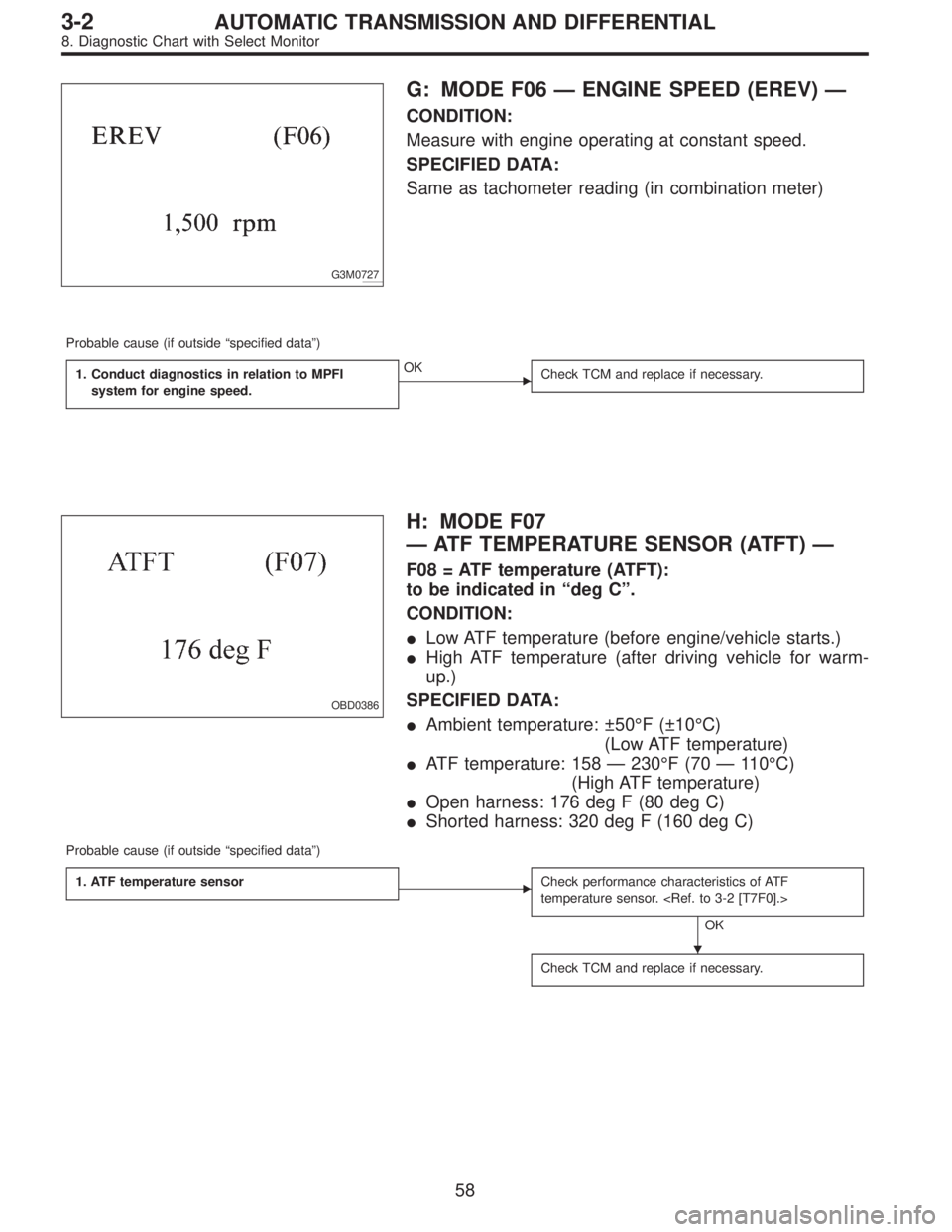
G3M0727
G: MODE F06—ENGINE SPEED (EREV)—
CONDITION:
Measure with engine operating at constant speed.
SPECIFIED DATA:
Same as tachometer reading (in combination meter)
Probable cause (if outside“specified data”)
1. Conduct diagnostics in relation to MPFI
system for engine speed.
�OK
Check TCM and replace if necessary.
OBD0386
H: MODE F07
—ATF TEMPERATURE SENSOR (ATFT)—
F08 = ATF temperature (ATFT):
to be indicated in“deg C”.
CONDITION:
�Low ATF temperature (before engine/vehicle starts.)
�High ATF temperature (after driving vehicle for warm-
up.)
SPECIFIED DATA:
�Ambient temperature: ±50°F (±10°C)
(Low ATF temperature)
�ATF temperature: 158—230°F (70—11 0°C)
(High ATF temperature)
�Open harness: 176 deg F (80 deg C)
�Shorted harness: 320 deg F (160 deg C)
Probable cause (if outside“specified data”)
1. ATF temperature sensor
�Check performance characteristics of ATF
temperature sensor.
OK
Check TCM and replace if necessary.
�
58
3-2AUTOMATIC TRANSMISSION AND DIFFERENTIAL
8. Diagnostic Chart with Select Monitor